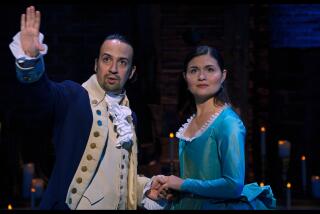‘Patriot’s’ Skirmish With Truth
- Share via
Hollywood deserves credit for bucking the supposed jinx on movies about the American Revolution and releasing “The Patriot” with Mel Gibson for this Fourth of July season. But rating the film itself is a tougher call.
Alongside other historical epics like “Braveheart,” “Glory” and “The Last of the Mohicans,” it falls a bit short. The first two-thirds of the film, reasonably gripping, disprove some of the criticism of the early reviews. But during the last 30 or 40 minutes, it suffers from a rising ratio of second-rate dialogue and historical distortion.
Let me stipulate: Historical nit-picking should--and usually does--leave a great epic unscathed. Most viewers know or couldn’t care less. “Braveheart” worked despite Gibson’s ersatz Irish sidekick and phony romance with a French princess. “The Last of the Mohicans” worked despite the romantic claptrap about Chingachgook and Uncas--plenty of other Mohicans still lived in New England--and the lurid death of Col. Munro (who in reality lived to ride into nearby Fort Edward the next day).
The makers of “The Patriot,” however, courted a higher standard by targeting our millennial Fourth of July and identifying the Smithsonian Institution as their historical consultant. The resulting ambivalent reviews and skepticism as to accuracy helped ensure holiday weekend box-office returns in which “The Perfect Storm” wiped out “The Imperfect History.” A more sophisticated script would have gotten better publicity for what could have been a great movie.
“The Patriot” is more or less accurate about the frontier violence in the French and Indian War 15 to 20 years earlier that haunts Gibson’s fictional character, Benjamin Martin, and leaves him averse to fighting again.
According to screenwriter Robert Rodat, “Our Benjamin Martin has liberal amounts of Thomas Sumter, Andrew Pickens, Daniel Morgan and even Elijah Clark, as well as Francis Marion.” Sumter was the man who didn’t want to fight again in 1780 until the British burned the cottage to which his wife and son had been sent. Like Benjamin Martin, Sumter had his fill of burning and killing in the French and Indian War period, and one biographer has noted that Sumter’s fighting style sometimes verged on the berserk. Would such a man have taken sons ages 11 and 13 with him to fire occasional shots at a small British party from which he is trying to rescue his oldest son, as “The Patriot” does? Conceivably. The boys already would have known how to shoot squirrels and rabbits and could probably have evaded British redcoats in the local woods.
The movie does leave viewers with a mistaken sense that everyone in South Carolina wore decent clothes and lived in a spacious farmhouse or mansion. In fact, most whites in the back country lived in cabins or crude huts. However, Sumter, Marion, Pickens and Morgan were all prosperous farmers or plantation owners. The large stone house of Gen. Daniel Morgan, who commanded for the patriots at the Battle of Cowpens, the movie’s endgame, still survives in Winchester, Va., and would not look out of place in an upscale Philadelphia or Baltimore suburb.
The American Revolution was especially brutal in the Carolinas. Neighbor fought neighbor, with the ruthlessness such civil wars usually entailed. British and Loyalist forces burned several Presbyterian churches, and both sides burned buildings that sometimes had people in them.
The makers of “The Patriot” confuse this by putting all the Loyalist troops in red uniforms to make the battle scenes more clear. The movie’s dragoons under the fictional Col. Tavington were given red and green uniforms, whereas the actual mounted British Legion under Lt. Col. Banastre Tarleton consisted of American Loyalists in green uniforms. Indeed, Edward McCrady, a South Carolina historian, has estimated that 103 of the state’s battles and skirmishes during the Revolution--roughly three-quarters of the total--involved South Carolinians (or at least Americans) on both sides. These divisions and the particularly brutal nature of the local war go hand in hand.
Which brings us to the film’s not inconsiderable failures and inaccuracies. The two most egregious are the inaccurate portraits of the British and the place of blacks in the colonial South Carolina of that era. A review in the Washington Post, besides locating the Battle of Cowpens in North Carolina and misidentifying Francis Marion as the model for Benjamin Martin, chortled that one of the good things about the movie’s heavy-handed treatment of the British was that it would annoy Tina Brown, the British former editor of the New Yorker. Probably so, and many other Brits with her.
American movies about 18th century North America tend to caricature British officers as supercilious elitists. Add German director Roland Emmerich and a star raised in Australia, and you have a heavy hand indeed. Taking Tarleton’s troops out of the green Loyalist uniforms that marked them as Americans has a plausible explanation. Still, the downside is to over-attribute their bad behavior to British thinking. The Cornwallis and Tarleton portrayals are also inflammatory. It is hard to believe that the historic consultation of the Smithsonian Institution went beyond dresses, uniforms and hairstyles.
Cornwallis, who succeeded to his father’s earldom at age 24, became aide-de-camp to King George III at 27 and full colonel of his own regiment at 28. He was only 42 at the time of the Carolina campaign and entered it with a record of successful fighting and little respect for the Colonials.
Tarleton, who had risen from the equivalent of second lieutenant at 18 to be a lieutenant colonel at 26 because of skill as a hard-charging cavalryman, was perhaps Cornwallis’ top protege in the Carolinas. They were not at loggerheads; Cornwallis had tolerated plundering and misbehavior by his troops in New Jersey and did so again marching from the Carolinas to Yorktown in 1781. After his failure in America, a more mature Cornwallis gained undoubted military distinction in India. Later he put down the Irish rebellion of 1798.
Tarleton has always had a bad reputation in the United States because of his spirited participation in the savage war in the Carolinas. But there is no record that he burned a church full of people, and he did not die at Cowpens (or in America). Nor was he afraid, as the movie suggests, that his actions made it impossible to return to England. He did indeed go back, and served as a member of Parliament for all but one year from 1790 to 1812. He was an Oxford man and wrote “A History of the Campaigns of 1780 and 1781 in the Southern Provinces of North America.”
The most egregious misportrait in “The Patriot” involves the life and status of blacks in South Carolina circa 1780. Although Gibson’s character is supposed to have freed his slaves, Thomas Sumter and Francis Marion both had slaves. The film shows a black enlistee in troops that had to be South Carolina militia. But blacks did not serve as fighting men in South Carolina army units, although they did in the South Carolina navy. The irony is that this false bit of political correctness, with some sappy attendant dialogue, could have been replaced by a more engaging truth.
South Carolina’s repeated refusal to let blacks bear arms was a subject of some internal controversy. Proposals to raise local black troops, which came with the recommendation of Congress, were several times put before the new state legislature during the Revolution, but always lost, despite their sponsorship by the influential Laurens family, including Henry Laurens, who was the president of the Continental Congress. A number of blacks did serve in unarmed capacities. Gen. Thomas Sumter was accompanied almost everywhere by his black bodyguard, Soldier Tom. In 1783, the South Carolina Legislature voted to free Antigua, a slave who had secured vital information by spying on the British. Some of this could have been in the film.
Most of all, the movie could have climaxed at Cowpens with a different, just-as-it-happened battle between two colonels--Tarleton and the leader of the American cavalry, William Washington, the cousin of the patriot commander in chief. Tarleton, whose rich merchant father had been a Liverpool slave trader in his early days, and two other dragoon officers were about to kill the American colonel when Washington was saved by the pistol shot of his black bugle boy, who was too small to wield a saber. Tarleton rode off.
The script could have given Gibson a more real version of this combat. And because it is recorded not only in books but in an 1845 painting by William Ranney, truth would have triumphed over reviewer cynicism. With more authenticity, “The Patriot” might even have tied “The Perfect Storm.”
Ah well. Maybe next time.
*
Kevin Phillips is an author and commentator. His most recent book, “The Cousins’ Wars: Religion, Politics and the Triumph of Anglo-America,” was a finalist for the 1999 Pulitzer Prize in history.
More to Read
Only good movies
Get the Indie Focus newsletter, Mark Olsen's weekly guide to the world of cinema.
You may occasionally receive promotional content from the Los Angeles Times.










